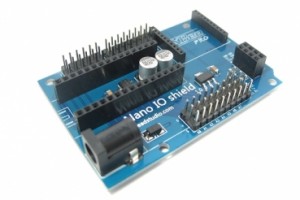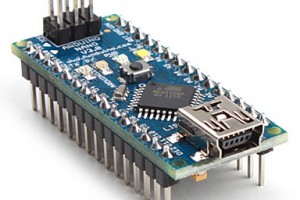Das Arduino Nano ist speziell für die Anwenung auf Breadboards entwickelt wurden.
Alle Pins sind auf Stiftleisten herausgeführt, die hier angebotene Version besitzt den neuen ATMega328 als Controller.
Die vollständigen technischen Daten sind in Englisch verfügbar:
It has everything that Diecimila has (electrically) with more analog input pins and onboard +5V AREF jumper. Physically, it is missing power jack and power select jumper. Since the Nano is automatically sense and switch to the higher potential source of power, there is no need for the power select jumper.
Nano?s got the breadboard-ability of the Boarduino and the Mini+USB with smaller footprint than either, so users have more breadboard space. It?s got a pin layout that works well with the Mini or the Basic Stamp (TX, RX, ATN, GND on one top, power and ground on the other). It?s a four-layer board with power and ground planes to help provide ICs with sufficient charge during switching and reduce noise (EMC) on high speed switching I/O pins. Ground plane help reduce radiation (EMI). Power plane is low in inductance; therefore any transients that may develop on the power line will be at lower levels.
Schematic and Design
Arduino Nano Manual (pdf)
Eagle files note: since the free version of Eagle does not handle more than 2 layers,and the Nano is currently 4-layer board, Gravitech publishes it here as unrouted, so users can at least open it and use it in the free version of Eagle
Specifications:
Microcontroller Atmel ATmega328
Operating Voltage (logic level) 5 V
Input Voltage (recommended) 7-12 V
Input Voltage (limits) 6-20 V
Digital I/O Pins 14 (of which 6 provide PWM output)
Analog Input Pins 8
DC Current per I/O Pin 40 mA
Flash Memory 32 KB (of which 2KB used by bootloader)
SRAM 2 KB
EEPROM 1 KB
Clock Speed 16 MHz
Dimensions 0.73? x 1.70?
Features:
Automatic reset during program download
Power OK blue LED on the bottom
Green (TX), red (RX) and orange (L) LED
+5V to AREF jumper
Auto sensing/switching power input
Small mini-B USB for programming and serial monitor
ICSP header for direct program download
Power OK blue LED on the bottom
Standard 0.1? spacing DIP (breadboard friendly)
Manual reset switch
Power:
The Arduino Nano can be powered via the mini-B USB connection, 6-20V unregulated external power supply (pin 30), or 5V regulated external power supply (pin 27). The power source is automatically selected to the highest voltage source.
The FTDI FT232RL chip on the Nano is only powered if the board is being powered over USB. As a result, when running on external (non-USB) power, the 3.3V output (which is supplied by the FTDI chip) is not available and the RX and TX LEDs will flicker if digital pins 0 or 1 are high.
Memory
The ATmega328 on the Nano has 32 KB of flash memory for storing code (of which 2 KB is used for the bootloader). It has 2 KB of SRAM and 1 KB of EEPROM (which can be read and written with the EEPROM library).
Input and Output
Each of the 14 digital pins on the Nano can be used as an input or output, using pinMode(), digitalWrite(), and digitalRead() functions. They operate at 5 volts. Each pin can provide or receive a maximum of 40 mA and has an internal pull-up resistor (disconnected by default) of 20-50 kOhms. In addition, some pins have specialized functions:
Serial: 0 (RX) and 1 (TX). Used to receive (RX) and transmit (TX) TTL serial data. These pins are connected to the corresponding pins of the FTDI USB-to-TTL Serial chip.
External Interrupts: 2 and 3. These pins can be configured to trigger an interrupt on a low value, a rising or falling edge, or a change in value. See the attachInterrupt() function for details.
PWM: 3, 5, 6, 9, 10, and 11. Provide 8-bit PWM output with the analogWrite() function.
SPI: 10 (SS), 11 (MOSI), 12 (MISO), 13 (SCK). These pins support SPI communication, which, although provided by the underlying hardware, is not currently included in the Arduino language.
LED: 13. There is a built-in LED connected to digital pin 13. When the pin is HIGH value, the LED is on, when the pin is LOW, it's off.
The Nano has 8 analog inputs, each of which provide 10 bits of resolution (i.e. 1024 different values). By default they measure from ground to 5 volts, though is it possible to change the upper end of their range using the analogReference() function. Additionally, some pins have specialized functionality:
I2C: 4 (SDA) and 5 (SCL). Support I2C (TWI) communication using the Wire library (documentation on the Wiring website).
There are a couple of other pins on the board:
AREF. Reference voltage for the analog inputs. Used with analogReference().
Reset. Bring this line LOW to reset the microcontroller. Typically used to add a reset button to shields which block the one on the board.
Alle Pins sind auf Stiftleisten herausgeführt, die hier angebotene Version besitzt den neuen ATMega328 als Controller.
Die vollständigen technischen Daten sind in Englisch verfügbar:
It has everything that Diecimila has (electrically) with more analog input pins and onboard +5V AREF jumper. Physically, it is missing power jack and power select jumper. Since the Nano is automatically sense and switch to the higher potential source of power, there is no need for the power select jumper.
Nano?s got the breadboard-ability of the Boarduino and the Mini+USB with smaller footprint than either, so users have more breadboard space. It?s got a pin layout that works well with the Mini or the Basic Stamp (TX, RX, ATN, GND on one top, power and ground on the other). It?s a four-layer board with power and ground planes to help provide ICs with sufficient charge during switching and reduce noise (EMC) on high speed switching I/O pins. Ground plane help reduce radiation (EMI). Power plane is low in inductance; therefore any transients that may develop on the power line will be at lower levels.
Schematic and Design
Arduino Nano Manual (pdf)
Eagle files note: since the free version of Eagle does not handle more than 2 layers,and the Nano is currently 4-layer board, Gravitech publishes it here as unrouted, so users can at least open it and use it in the free version of Eagle
Specifications:
Microcontroller Atmel ATmega328
Operating Voltage (logic level) 5 V
Input Voltage (recommended) 7-12 V
Input Voltage (limits) 6-20 V
Digital I/O Pins 14 (of which 6 provide PWM output)
Analog Input Pins 8
DC Current per I/O Pin 40 mA
Flash Memory 32 KB (of which 2KB used by bootloader)
SRAM 2 KB
EEPROM 1 KB
Clock Speed 16 MHz
Dimensions 0.73? x 1.70?
Features:
Automatic reset during program download
Power OK blue LED on the bottom
Green (TX), red (RX) and orange (L) LED
+5V to AREF jumper
Auto sensing/switching power input
Small mini-B USB for programming and serial monitor
ICSP header for direct program download
Power OK blue LED on the bottom
Standard 0.1? spacing DIP (breadboard friendly)
Manual reset switch
Power:
The Arduino Nano can be powered via the mini-B USB connection, 6-20V unregulated external power supply (pin 30), or 5V regulated external power supply (pin 27). The power source is automatically selected to the highest voltage source.
The FTDI FT232RL chip on the Nano is only powered if the board is being powered over USB. As a result, when running on external (non-USB) power, the 3.3V output (which is supplied by the FTDI chip) is not available and the RX and TX LEDs will flicker if digital pins 0 or 1 are high.
Memory
The ATmega328 on the Nano has 32 KB of flash memory for storing code (of which 2 KB is used for the bootloader). It has 2 KB of SRAM and 1 KB of EEPROM (which can be read and written with the EEPROM library).
Input and Output
Each of the 14 digital pins on the Nano can be used as an input or output, using pinMode(), digitalWrite(), and digitalRead() functions. They operate at 5 volts. Each pin can provide or receive a maximum of 40 mA and has an internal pull-up resistor (disconnected by default) of 20-50 kOhms. In addition, some pins have specialized functions:
Serial: 0 (RX) and 1 (TX). Used to receive (RX) and transmit (TX) TTL serial data. These pins are connected to the corresponding pins of the FTDI USB-to-TTL Serial chip.
External Interrupts: 2 and 3. These pins can be configured to trigger an interrupt on a low value, a rising or falling edge, or a change in value. See the attachInterrupt() function for details.
PWM: 3, 5, 6, 9, 10, and 11. Provide 8-bit PWM output with the analogWrite() function.
SPI: 10 (SS), 11 (MOSI), 12 (MISO), 13 (SCK). These pins support SPI communication, which, although provided by the underlying hardware, is not currently included in the Arduino language.
LED: 13. There is a built-in LED connected to digital pin 13. When the pin is HIGH value, the LED is on, when the pin is LOW, it's off.
The Nano has 8 analog inputs, each of which provide 10 bits of resolution (i.e. 1024 different values). By default they measure from ground to 5 volts, though is it possible to change the upper end of their range using the analogReference() function. Additionally, some pins have specialized functionality:
I2C: 4 (SDA) and 5 (SCL). Support I2C (TWI) communication using the Wire library (documentation on the Wiring website).
There are a couple of other pins on the board:
AREF. Reference voltage for the analog inputs. Used with analogReference().
Reset. Bring this line LOW to reset the microcontroller. Typically used to add a reset button to shields which block the one on the board.
No projects use this part yet.
Attributes
| Analoge Eingänge: | 8 | |
| Breite: | 18mm | |
| Digitale I/O Pins: | 14 | |
| EEPROM: | 1kb | |
| Eingangsspannung (empfohlen): | 7-12V | |
| Eingangsspannung (limit): | 6-20V | |
| Flash Speicher: | 32kb | |
| Länge: | 33mm | |
| Mikrocontroller: | ATmega328 | |
| PWM Pins: | 6 | |
| Spannung: | 5V | |
| SRAM: | 2kb | |
| Strom pro I/O Pin: | 40mA | |
| Taktfrequenz: | 16MHz |
Info
| Best Price | 39 € | ||
| Best Bulk Price | 37.5 € | ||
| Friends Stock | 0 | ||
| Overall Stock | 0 | ||
| Login to add to stock | |||
| 0 Projects use this part. | |||
| Created: | 2013-05-23 09:03:16 | ||
| Last Update: | 2013-10-20 06:47:48 | ||

